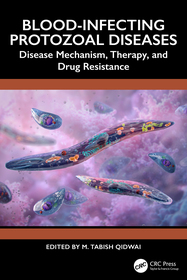
Blood-Infecting Protozoal Diseases
Disease Mechanism, Therapy, and Drug Resistance
- Publisher's listprice GBP 110.00
-
52 552 Ft (50 050 Ft + 5% VAT)
The price is estimated because at the time of ordering we do not know what conversion rates will apply to HUF / product currency when the book arrives. In case HUF is weaker, the price increases slightly, in case HUF is stronger, the price goes lower slightly.
- Discount 10% (cc. 5 255 Ft off)
- Discounted price 47 297 Ft (45 045 Ft + 5% VAT)
Subcribe now and take benefit of a favourable price.
Subscribe
52 552 Ft

Availability
Not yet published.
Why don't you give exact delivery time?
Delivery time is estimated on our previous experiences. We give estimations only, because we order from outside Hungary, and the delivery time mainly depends on how quickly the publisher supplies the book. Faster or slower deliveries both happen, but we do our best to supply as quickly as possible.
Product details:
- Edition number 1
- Publisher CRC Press
- Date of Publication 28 November 2025
- ISBN 9781032522753
- Binding Hardback
- No. of pages264 pages
- Size 234x156 mm
- Weight 453 g
- Language English
- Illustrations 10 Illustrations, black & white; 26 Illustrations, color; 5 Halftones, color; 5 Line drawings, black & white; 26 Line drawings, color; 18 Tables, black & white 700
Categories
Short description:
This reference book compiles the latest literature on the genetic diversity, therapeutics, and drug resistance in protozoan parasites, with a focus on malaria parasites, Plasmodium falciparum, and P. vivex. The book covers the mechanisms of drug resistance, drug resistance detection and spread, and factors affecting drug resistance.
MoreLong description:
The present book describes the common human diseases caused by the blood infecting protozoans, diagnosis and treatment. This book compiles the latest literature on the genetic diversity, therapeutics, and drug resistance in protozoan parasites, with a focus on malaria parasites, Plasmodium falciparum, and P. vivex. It explores the association of parasite genetic makeup with drug resistance. The book covers the mechanisms of drug resistance, and its spread, and factors affecting drug resistance. The book facilitates research design and development of therapeutics against malarial parasites. The book is meant for post-graduate students of microbiology, parasitology, and medicine, as well as healthcare workers, medical practitioners, public health staff, and policymakers.
Key Features
- Describes the recent updates on how the different protozoan parasites cause human diseases
- Includes the genomics and epidemiology of important protozoan parasites like Plasmodium, Trypanosoma, Leishmania, and Toxoplasma.
- Further, it covers the role of nanotechnology in diagnosis and treatment of the diseases.
- Covers the detection of drug resistance in vitro and in vivo and Insilco tools for functional genomics.
- Throws light on the aspect of copy number variation (CNV) as a part of the adaption strategy in parasites.
- Discusses the molecular basis of antimalarial drug resistance in Plasmodium vivax.
- Reviews the factors contributing to the spread of resistance in malaria parasites.
Table of Contents:
1. Current updates on the causes of human diseases resulting from protozoan parasites. 2. Understanding the genomics and epidemiology of common protozoan diseases. 3. Diagnosis and treatment of protozoan diseases: an update. 4. Nanotechnology in diagnosis and treatment of protozoan diseases. 5. The emergence and spread of drug resistance in blood infecting protozoans: a major threat to human health. 6. Mechanism of drug resistance and treatment failure in Leishmaniasis, trypanosomiasis, Toxoplasma gondii and Babesia. 7. Investigation of sesquiterpene lactone endoperoxides and associated genetic markers for drug resistance in P. falciparum. 8. Drug resistance marker for Amino alcohols, Aminoquinolines, and antifolates in P. falciparum. 9. Molecular basis of antimalarial drug resistance in Plasmodium sp., current challenges and future perspectives. 10. Unmasking influential factors in malaria drug resistance transmission. 11. Detection of resistance: assessing in vivo and in vitro drug resistance in malaria parasite. 12. Monitoring of Plasmodium Genetic Diversity and Drug Resistance Can Be an Effective Tool for Malaria Elimination in Resource-Limited Endemic Regions.
More



